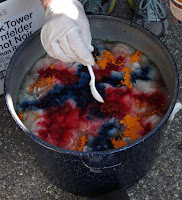 |
| colour gamp in neutrals |
At our May guild meeting members were given a chance to see what the Colour Study Group and the More Than Four Study Group had been doing.
The colour group have been working on neutral colours. First they had to identify what made a colour "neutral". Then they considered how these colours react when woven in different structures. As part of the learning process the members of the group wove samples.
 |
| log cabin colour gamp |
The More Than Four Group gave a brief report about their exploration into 3 dimensional surface effects. (More details can be found in the March 15, 2015 post.) Sampling has been very important for this study topic as the effects depend upon many factors especially the materials and the finishing techniques. Most recent efforts include experimenting with "dimity" as illustrated in the photo of the scarf. Dimity creates raised stripes against a plain background.
 |
| dimity |
 |
| double weave |
 To celebrate the good weather a group of guild members decided to hold a "dye day". They fired up those old camp stoves and brought out their fleece and yarn. The theme appears to be, try anything, sprinkle the dye on top of the fleece, dip dye or create variegated yarn. Who knows what the result will be and that is part of the fun. No doubt we will be seeing the finished products later in the year.
To celebrate the good weather a group of guild members decided to hold a "dye day". They fired up those old camp stoves and brought out their fleece and yarn. The theme appears to be, try anything, sprinkle the dye on top of the fleece, dip dye or create variegated yarn. Who knows what the result will be and that is part of the fun. No doubt we will be seeing the finished products later in the year. 

If all this activity were not enough to tire us out guild members have also been working on projects in the guild studio. Look for the next post to see how the projects have turned out.






